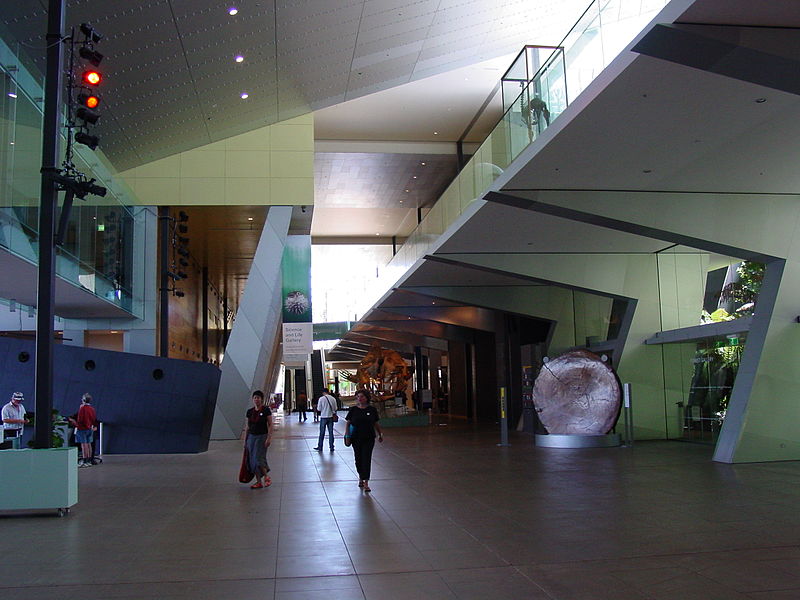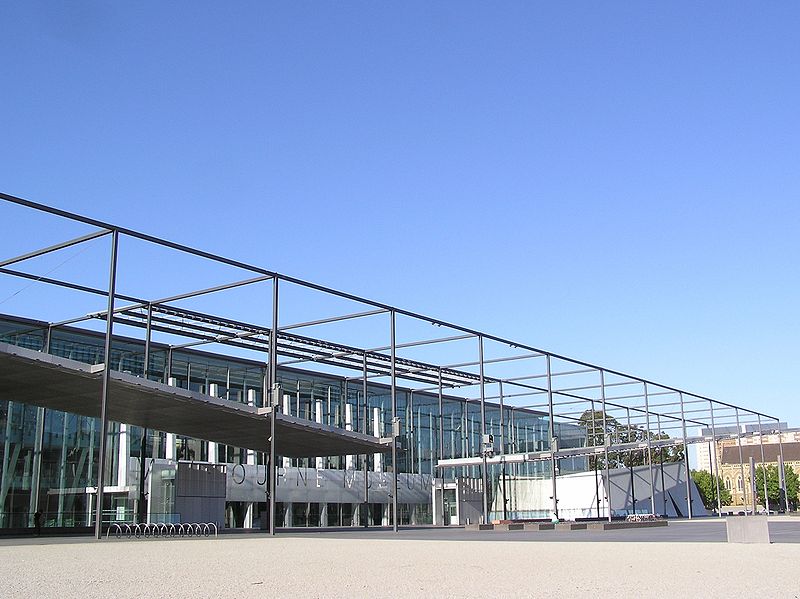It was designed by Denton Corker Marshall Architects and finished construction in 2001. Situated in the Carlton Gardens, it was commissioned by the Victorian Government Office of Major Projects on behalf of Museums Victoria. The museum is a rich response to Melbourne’s urban condition, and provides a place for education, history, culture and society to engage with each other in a contemporary setting. It is now an important part of Melbourne’s soft infrastructure.
It is the largest museum in the Southern Hemisphere, and is a venue of Museum Victoria, which also operates the Immigration Museum and Scienceworks Museum.
The museum has seven main galleries, a Children's Gallery and a temporary exhibit gallery on three levels, Upper, Ground and Lower Level and was constructed by Baulderstone Hornibrook.
The Touring Hall is where temporary exhibits are displayed. Past exhibits include mummies from Egypt and dinosaurs from China. The Big Box is part of the Children's Gallery.
In addition, the museum has other facilities such as the Sidney Myer Amphitheatre and The Age Theatre. The Discovery Centre, on the Lower Level, is a free public research centre. The museum also has a cafe and a souvenir shop.

Description
The Melbourne Museum is a post-modernist building, structured with a grid-like order that embraces eccentric metal clad forms extruding out and creating an irregular sculptural composition with moments of abstract colour throughout the building. A building of the public, the museum is arranged in a volumetrically individual layout, referencing Melbourne’s iconic Hoddle Grid, which allows the importance of each component of the buildings historical, cultural and social significance to be read in loosely equal hierarchy and individuality, examples being the Imax theatre, and Aboriginal centre. The building is can be dissected into different spaces so an individual can navigate through and around the building in an orthogonal manner. It is both a single building, and a network of individual buildings integrated into the landscape of the Carlton Gardens. The new museum is axially aligned with the adjacent neo-classical Royal Exhibition Centre, and references it along with the skyscrapers of Melbourne’s central business district, with its monumental scale, and horizontality with protruding vertical facets. The sticks and blades that make up the Melbourne Museum are signatures of Denton Corker Marshall’s architecture. The most iconic detail of the building is the spectacular cantilever that projects over to the west, on the central axis with the Royal Exhibition centre, this cantilever can be seen from kilometres away. On the northern side resides a large, taller sloped roof than that of the cantilever, similar in scale to the dome of the Royal Exhibition building.
Main permanent exhibits
The main permanent exhibits include:- Science and Life Gallery - including a skeleton of a Diprotodon (a giant wombat-like creature), and skeletons of dinosaurs such as:
- Tarbosaurus (Giant meat eater, Tyrannosauridae)
- Mamenchisaurus (Giant Sauropod)
- Tsintaosaurus
- Hadrosaurid
- Pteranodon
- Gallimimus
- Hypsilophodon
-
- Muttaburrasaurus
- Tiktaalik
- Anomalocaris
- and many other prehistoric animals.
- The Science & Life Gallery also contains the exhibitions: Bugs Alive!, Marine Life: Exploring our seas and two more exhibitions soon to open in 2010.
- Melbourne Gallery - where the mounted hide of Phar Lap, a race horse that won the Melbourne Cup during the depression era, is exhibited.
- It also features an exhibition about the history of Melbourne from the early 19th century through to present day (called The Melbourne Story).
- Large skeleton of a Pygmy Blue Whale
- Mind and Body Gallery - a gallery regarding the human body. It also features a world first exhibition about the mind (called The Mind: enter the labyrinth).
- Evolution Gallery - the upper level features the exhibition 'Darwin to DNA'. The lower level feature Wild: Amazing animals in a changing world exhibition.
- Forest Gallery - a living temperate Victorian forest environment, complete with live birds, reptiles, and other fauna
- Bunjilaka Aboriginal Cultural Centre - a gallery with exhibitions about the Aborigines of Victoria
- Te Pasifika Gallery - an exhibition which highlights the history and watercrafts of Pacific Islanders
- Children's Gallery - exhibitions aimed at 3 to 8 year olds.
- Touring Hall - is where international touring exhibitions are displayed. A Day In Pompeii which was on display at Melbourne Museum from 26 June - 25 October 2009 was Melbourne Museum's most popular temporary exhibition. Past Touring Hall exhibitions include Hatching the Past: Dinosaur Eggs and Babies (30 May 2008 to 24 August 2008), The Great Wall of China: Dynasties, dragons and warriors (23 March 2007 to 22 July 2007), Spirit of the Games: the Opening Ceremony revealed (18 March to 23 July 2006), Dinosaurs from China (2005).
- Public spaces - Outside the main galleries are various displays
relating to Victoria's and Australia's history, including CSIRAC (an
early computer built in Australia) and a Pygmy Blue Whale.



No comments:
Post a Comment